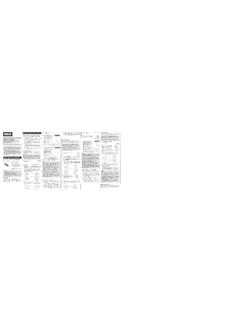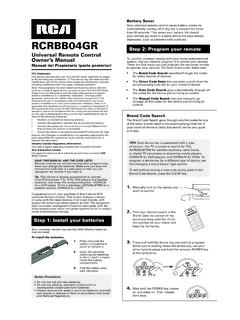Transcription of Chapter 1 Specifications Chapter 2 Installation RCI ...
1 RCI-6300F25/150 AM/FM Amateur Transceiver With Built-in Frequency Counter owner 's manual - 1 - Table of Contents PAGE Chapter 1 Specifications .. 2 Chapter 2 Installation .. 3 Installing the 3 Ignition Noise Interference .. 4 Antenna .. 4 External Speaker .. 4 Public Address .. 4 Chapter 3 Operation .. 5 Controls and Indicators .. 5 Front Panel .. 5 Rear Panel .. 8 Operation .. 9 Microphone .. 9 Procedure to Receive .. 10 Procedure to Transmit .. 10 Memo .. 11 LIMITED WARRANTY .. Inside Back Cover - 2 - Chapter 1 Specifications GENERAL Model RCI-6300F25 RCI-6300F150 Frequency Range : 1.
2 ~ MHz 1. ~ MHz 2. ~ MHz 2. ~ MHz 3. ~ MHz 3. ~ MHz 4. ~ MHz 4. ~ MHz 5. ~ MHz 5. ~ MHz 6. ~ MHz 6. ~ MHz Modes PA/FM/AM PA/FM/AM Frequency Control Phase-Lock-Loop Synthesizer Phase-Lock-Loop Synthesizer Frequency Stability Temperature Range -30OC to +50OC -30OC to +50OC Input Voltage DC V DC V Antenna Impedance 50 ohms 50 ohms Size 7 3/4" (W) x 10 3/4" (L) x 2 3/8" (H) 7 7/8" (W) x 9 1/4" (D) x 2 7/8" (H) Weight 4 lb. 3 oz. 6 lb. TRANSMITTER RF Power Output AM/FM : 10W. AM/FM : 50W. DC Carrier AM : 150W. Peak Power, @ 100% Modulation Spurious Emissions -50 dB -50 dB Audio Distortion 10% 10% Frequency Response 300 to 2500Hz 300 to 2500Hz Microphone Dynamic Dynamic RECEIVER Sensitivity AM : uV for 10dB S+N/N FM : uV for 12dB S+N/N AM : uV for 10dB S+N/N FM : uV for 12dB S+N/N Squelch Sensitivity Selectivity -55 dB -55 dB Image Rejection 50 dB 50 dB Hum & Noise 40dB 40dB Audio Power Output at 10% THD at 10% THD ( Specifications SUBJECT TO CHANGE WITHOUT NOTICE ) - 3 - Chapter 2 Installation Installing the Radio Choose a convenient location for operation that does not interfere with drive or passenger.
3 This radio is supplied with a universal mounting bracket. When mounting the bracket and radio to your car, make sure it is mechanically strong. Also, provide a good electrical grounding connection to the chassis of the vehicle. Proceed as follows to install the radio. 1. Locate a convenient area in your vehicle for the Installation of the radio. Hold the mounting bracket with the radio in the location where the radio is to be installed. Make sure nothing will interfere with either the radio or the mounting bolts. Mark and then drill holes for the mounting bracket. 2. Most radio antennas come equipped with a PL-259 plug. Connect this plug to the ANT. Jack in the rear of the radio. 3. Extending from the rear of the radio is a fused red and black wire for the DC connections to the vehicle s electrical system.
4 For best performance, it is strongly recommended that the red lead be taken directly to the positive terminal on the vehicle s battery and the black lead be connected to the nearest chassis ground. (Note: This radio is designed for vehicles with negative ground systems.) Connections should be made using appropriate crimp on lugs of a size large enough to make good contact with the bolt used to fasten to the battery and the chassis ground, It is a good safety idea to install a second fuse, in series with the red wire at the battery connection. This second fuse would provide protection in case the red wire was to fray or get pinched and short to the body of the vehicle, some where between the battery and the radio. High power radios such as this one require large DC current flow when in the TX mode.
5 Poor power connections cause supply voltage drops that can substantially decrease the performance of your radio. A good DC connection is probably one of the most important things for getting the best transmitter performance and in some cases, least receiver noise. - 4 - Installation (Continued) 4. Mount the microphone bracket near the radio in an easily accessible spot using the two screws provided. Ignition Noise Interference With weak signals, you may experience interference of the signal by background noise. This radio has NB and ANL controls which will help reduce background noise from sources such as your ignition system. However, background electrical noise may come from several sources and all noise may not be eliminated. With extremely weak signals, you can operate this radio with the engine turned off, which should improve reception.
6 If the ignition noise level is too high to allow proper operation under most conditions, you should have your Installation of the radio checked by a qualified technician. Antenna This radio has a jack in the rear for a standard PL-259 antenna plug. If you are looking for the most range for your transmission, use a vertically polarized, quarter-wave length antenna. If antenna height is a problem, you may use a shorter, loaded-type whip antenna although you can expect some lost of transmission range. To improve performance, your antenna should be matched to your radio. Your antenna can be adjusted so that it matches your radio. External Speaker The external speaker jack (EXT. SPK) on the rear panel is used for remote receiver monitoring. The external speaker should have 8 ohms impedance and be able to handle at least 4watts.
7 When the external speaker is plugged in, the internal speaker is disconnected. Public Address To use the Public Address (PA) function, first connect an external speaker to the PA. SP. Jack on the rear of the radio. See the above Specifications for a proper external speaker. Keep the speaker away from the microphone to avoid acoustic feedback. - 5 - Chapter 3 Operation Controls and Indicators Front Panel 1. SQUELCH CONTROL: This control is used to control or eliminate receiver background noise in the absence of an incoming signal. For maximum receiver sensitivity, it is necessary that the control be adjusted only to the point where the receiver background noise is eliminated. Turn fully counterclockwise and then slowly clockwise until the receiver noise just disappears.
8 Any signal to be received must now be slightly stronger than the average received noise. Further clockwise rotation will increase the threshold level that a signal must overcome in order to be heard. Only strong signals will be heard at a maximum clockwise squelch setting. 2. ON/OFF VOLUME CONTROL: Turn clockwise to apply power to the radio and to set the desired listening level. 3. RF GAIN CONTROL: This control is used to reduce the gain of the RF amplifier under strong signal conditions. 4. MIC GAIN CONTROL: Adjust the microphone gain in the transmit mode. This control is used to set the audio level of the microphone for maximum performance and clarity. 11020191817161514131211234 6 7 8 95 Ranger- 6 - Operation (Continued) 5. MODE SWITCH: This switch allows you to select one of three following operating modes: PA/FM/AM.
9 6. Fr. POOL: The Frequency Pool allow the user to select the desired segments of frequencies. 7. ECHO/TIME CONTROL: The ECHO control is used for echo effect. The TIME control is used to control the intervals of the echo sound. 8. RF POWER CONTROL: This control enables adjustment of RF power output continuously up to the rated output power. 9. TALKBACK/OFF CONTROL: Adjust this knob for desired volume of Talkback. This is used to monitor your own voice. Or example, you could use this feature to compare different microphones. 10. CHANNEL SELECTOR: This control is used to select a desired transmit and receive channel. 11. FRONT PANEL METER: The front panel meter allows the user to monitor signal strength and RF power out level. 12. TX/RX LED: The red LED indicates the radio is in the transmit mode.
10 The green indicates the radio is in the receive mode. 13. FREQUENCY COUNTER: This frequency counter indicates the transmit frequency digitally. 14. DIM/BRT SWITCH: This switch is used to adjust the brightness of the meter and LED display for optimum intensity for day or nighttime driving. 15. HI/LOW TONE SWITCH: This switch changes tone quality in receive only. In LO position, bass is increased and in HI position, treble is increased. 16. S-RF/SWR SWITCH: In the S-RF position, the meter swings proportionally to the strength of the received signal. When transmitting, the meter indicates relative RF output power. When in the SWR - 7 - Operation (Continued) position, the Standing Wave Ratio (SWR) of your antenna. There are no adjustments because the SWR circuit this radio calibrates itself automatically.







